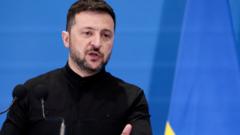With rising tensions in the Ukraine-Russia war, Ukraine is focusing on ramping up its domestic arms production and seeking monetary support from its allies to enhance its defense capabilities.
Ukraine Boosts Arms Production, Seeks Financial Support from Allies

Ukraine Boosts Arms Production, Seeks Financial Support from Allies
In a bid for self-reliance amidst ongoing conflict, Ukraine increases its arms manufacturing while asking Western nations for financial assistance.
In the heart of Ukraine, the noise of machines permeates a factory as workers assemble vital armored vehicles for military use in the ongoing conflict with Russia. As supplies from allies become more uncertain, Ukraine has committed to boosting its domestic arms manufacturing. According to Vladislav Belbas, the CEO of Ukrainian Armor, the firm that operates the factory, production has doubled from the previous year, yet more is needed to effectively counter Russian firepower.
The shift in Ukraine's strategy marks a significant change in reliance. Initially dependent on artillery and weapons supplied by Western nations, Ukraine is now asking for funding to produce its own military supplies, with approximately 40% of the weaponry at the front now manufactured domestically. This surge in self-sufficiency includes a substantial focus on drone technology, which has become a reliable asset on the battlefield.
However, the Ukrainian defense industry faces challenging funding obstacles. Defense analyst Olena Bilousova points out that while Ukraine has a production capacity valued at $35 billion per year, it currently only produces equipment valued at around $15 billion due to inadequate funding. Despite recent commitments from allies that increased financial support from $500 million to expectations of $1 billion, the gap remains significant.
The urgency to enhance arms production is underscored by Russia's expanding military capabilities. According to NATO figures, Russia produces three times the ammunition in three months compared to the entire NATO alliance's output in a year. This disparity has left Ukraine at a disadvantage on the battlefield, necessitating innovative adaptations including vehicles designed to evade drone detection.
Ukrainian Armor is pioneering several advanced projects, including unmanned carriers that are designed to reduce the risk to soldiers during supply missions. These vehicles not only save lives but also mitigate the substantial costs associated with soldier casualties. As artillery remains critical, Ukraine has claimed self-sufficiency in mortar production, a stark contrast to the earlier reliance on imports at the onset of the conflict.
To foster growth within its defense sector, Ukraine has initiated partnerships with Western allies for shared production facilities, allowing for weapons manufacturing in safer regions. Denmark has already expressed support for this initiative. Ukrainian President Volodymyr Zelensky has emphasized the need for investment in technology and production capabilities to bolster both Ukrainian defenses and those of Europe.
The ongoing conflict necessitates that Ukraine strengthens its military capabilities and fortifies global partnerships to navigate the evolving dynamics of warfare effectively. As Ukraine boosts its production pipeline, it hopes to transform its defense landscape while ensuring international allies contribute to these vital efforts.
The shift in Ukraine's strategy marks a significant change in reliance. Initially dependent on artillery and weapons supplied by Western nations, Ukraine is now asking for funding to produce its own military supplies, with approximately 40% of the weaponry at the front now manufactured domestically. This surge in self-sufficiency includes a substantial focus on drone technology, which has become a reliable asset on the battlefield.
However, the Ukrainian defense industry faces challenging funding obstacles. Defense analyst Olena Bilousova points out that while Ukraine has a production capacity valued at $35 billion per year, it currently only produces equipment valued at around $15 billion due to inadequate funding. Despite recent commitments from allies that increased financial support from $500 million to expectations of $1 billion, the gap remains significant.
The urgency to enhance arms production is underscored by Russia's expanding military capabilities. According to NATO figures, Russia produces three times the ammunition in three months compared to the entire NATO alliance's output in a year. This disparity has left Ukraine at a disadvantage on the battlefield, necessitating innovative adaptations including vehicles designed to evade drone detection.
Ukrainian Armor is pioneering several advanced projects, including unmanned carriers that are designed to reduce the risk to soldiers during supply missions. These vehicles not only save lives but also mitigate the substantial costs associated with soldier casualties. As artillery remains critical, Ukraine has claimed self-sufficiency in mortar production, a stark contrast to the earlier reliance on imports at the onset of the conflict.
To foster growth within its defense sector, Ukraine has initiated partnerships with Western allies for shared production facilities, allowing for weapons manufacturing in safer regions. Denmark has already expressed support for this initiative. Ukrainian President Volodymyr Zelensky has emphasized the need for investment in technology and production capabilities to bolster both Ukrainian defenses and those of Europe.
The ongoing conflict necessitates that Ukraine strengthens its military capabilities and fortifies global partnerships to navigate the evolving dynamics of warfare effectively. As Ukraine boosts its production pipeline, it hopes to transform its defense landscape while ensuring international allies contribute to these vital efforts.





















